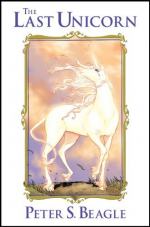|
This section contains 3,719 words (approx. 13 pages at 300 words per page) |

|
SOURCE: "Incongruity in a World of Illusion: Patterns of Humor in Peter Beagle's The Last Unicorn," in Extrapolation, Vol. 20, No. 3, Fall, 1979, pp. 230-37.
In the essay below, Stevens argues that Beagle uses humor to manipulate the tone of The Last Unicorn.
While humor is peripheral to much fantasy, it is central to Peter Beagle's The Last Unicorn. Beagle creates a quasimedieval universe with built-in anachronisms to serve as the setting for his fairy tale that is at once high romance and self-parody. He presents a serious theme, that we are what people think us and we become what we pretend to be, with a comic technique, and much of the success of the novel can be traced to its humor.
Beagle leaves no doubt about his comic intentions very early in the novel. Before any of the important mortal characters are introduced, the unicorn meets a butterfly. While...
|
This section contains 3,719 words (approx. 13 pages at 300 words per page) |

|


